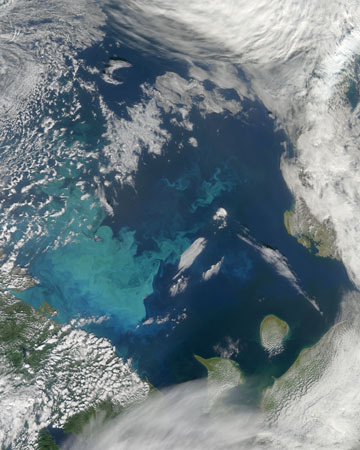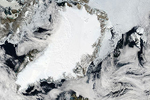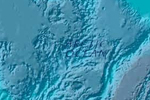As climate change melts the Arctic sea ice, nations are rushing to carve up once-inaccessible areas for oil and gas exploitation, industrial fishing, and shipping routes. Now, BBC reports that Russia and Norway have essentially agreed to split the Arctic’s Barents Sea in half —one of the region’s richest in biodiversity and ecological productivity—for industrial exploitation.
“The potential economic benefits are enormous,” said James Nixey, manager and research fellow for the Russia and Eurasia Program from Chatham House told the BBC. “The significance of the deal is that it is widely recognized that the Arctic is a scene of future commerce and possibly future conflict.”
While oil drilling and industrial fishing have already occurred in Barents Sea, the deal allows a far wider range of exploitation. Norway has signaled it will begin exploration for fossil fuel reserves once the agreement is implemented on July 7th.
According to a report by the WWF, Barents Sea is “one of the most productive oceans in the world and one of the most biologically diverse regions within the Arctic.”
A unique ecological and geographical position has created a haven for wildlife. Barents Sea’s “shallow structure, inflow of warm Atlantic water, and nutrient-rich upwelling support enormous concentrations of plankton, rich benthic communities, huge concentrations of migratory seabirds, some of the world’s largest fish stocks as well as a diverse community of sea mammals,” reads the WWF report.
 Phytoplankton bloom in Barents Sea. Photo by: NASA. |
The region is home to over 2,500 known deep sea invertebrates and 150 fish species; 40 seabird species breed in the region, while 12 species of whales are found at different times in the area. Seven species of seals, sea lions, and walrus; 5 dolphins species; and polar bears also inhabit the sea north of Norway and Russia.
Written in 2004, the WWF report states that “Barents Sea is among the cleanest and most undisturbed oceans in the world. At the same time, it is the most accessible region of the Arctic, and human activities are quickly expanding to even the most remote areas of the ecoregion.”
The industrial race to the Arctic is not without its opposition. For a few days this month non-violent Greenpeace activists halted exploration efforts by Cairn Energy for oil deposits in the deep sea off Greenland. In response, the energy company has threatened to bankrupt the green group in court. Greenpeace, which has dubbed such drilling as ‘dangerous lunacy’, wants the international community to set the entirety of historical sea ice off-limits to industrial exploitation.
Scientists have been warning for decades that rising greenhouse gas emissions is imperiling the stability of the Arctic environment, which has warmed far quicker than any other place in the world. Fossil fuels taken from the Arctic will only exacerbate the large-scale changes in the region.
Related articles
Arctic on the line: oil industry versus Greenpeace at the top of the world

(06/06/2011) At the top of the world sits a lone region of shifting sea ice, bare islands, and strange creatures. For most of human history the Arctic remained inaccessible to all but the hardiest of peoples, keeping it relatively pristine and untouched. But today, the Arctic is arguably changing faster than anywhere else on Earth due to global climate change. Greenhouse gases from society have heated up parts of the Arctic over the past half-century by 4-5 degrees Fahrenheit, leading to a staggering decline in the Arctic sea ice. The large-scale changes suffered by the Arctic have created a new debate over conservation and exploitation, a debate currently represented by the protests of Greenpeace against oil company Cairn Energy, both of whom have been interviewed by mongabay.com (see below).
New record in global carbon emissions ‘another wake-up call’
(05/31/2011) Global carbon emissions hit a new high last year proving once again that international political efforts, hampered by bickering, the blame-game, and tepidity, are failing to drive down the greenhouse gas emissions that are causing the planet to heat up. According to the International Energy Agency (IEA), following a slight fall in carbon dioxide emissions due to the economic downturn, emissions again rose to a new record level in 2010: 30.6 gigatons. This is a full 5 percent higher than the past record hit in 2008. The new record puts greater doubt on the international pledge of limiting the global average temperature rise to 2 degrees Celsius.
With pressure to drill, what should be saved in the Arctic?

(04/27/2011) Two major threats face the Arctic: the first is global climate change, which is warming the Arctic twice as fast the global average; the second is industrial expansion into untouched areas. The oil industry is exploring new areas in the Arctic, which they could not have reached before without anthropogenic climate change melting the region’s summer ice; but, of course, the Arctic wouldn’t be warming without a hundred years of massive emissions from this very same industry, thus creating a positive feedback loop that is likely to wholly transform the Arctic.